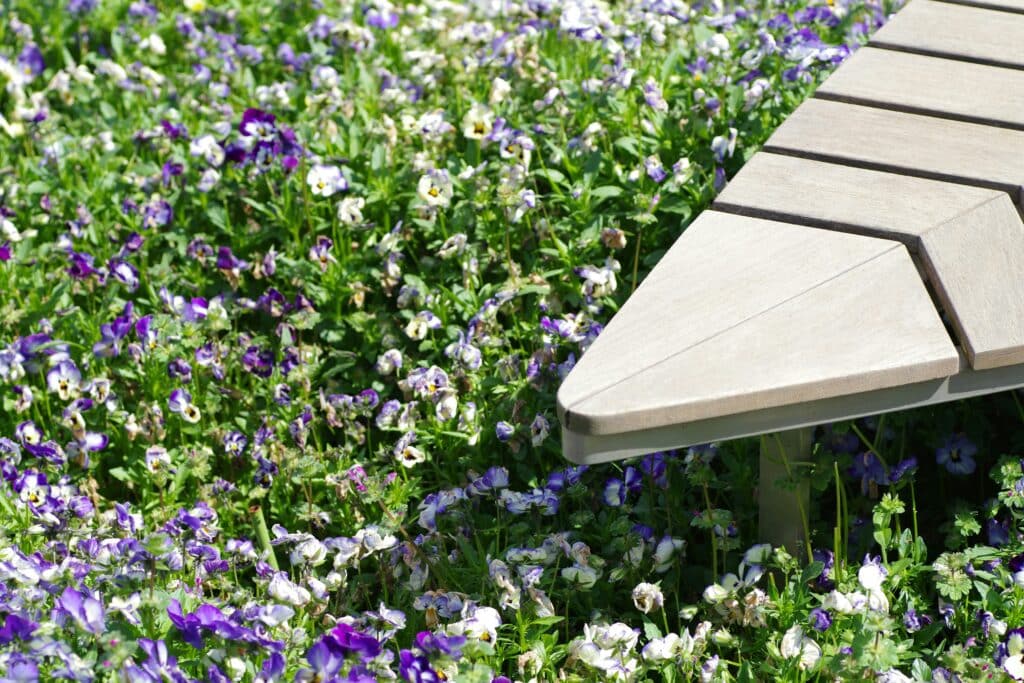🌷🌼 The concept of “Tire Flower Beds” has garnered attention for its uniqueness and environmental friendliness. This is a fantastic, cost-effective solution that not only makes your garden look vibrant and attractive, but also helps in reducing waste by repurposing old tires.

The forthcoming content will delve into the step-by-step process of creating your own tire flower beds. We’ll share insights on how to choose the right tires, how to prepare them for planting, and how to arrange them for the most visually pleasing effect. You’ll also discover the variety of plants and flowers that thrive in this unconventional garden bed. Not just a how-to guide, we also explore the environmental benefits of this gardening method. 🌍 You will see how this simple act of reusing tires can help reduce landfill waste and contribute to a healthier planet. Plus, we’ll look at other inspiring examples of tire garden beds from around the world to fuel your creativity.
As a bonus, we’ll also provide some maintenance tips to keep your tire flower beds in optimal condition year-round. These pointers will ensure that your blooming tire planters remain a standout feature in your garden for a long time. 🌺🌻
So, get ready to embark on this green journey and revamp your garden with tire flower beds. This innovative approach is not just about creating an appealing outdoor space but also embracing a lifestyle that values sustainability. Prepare to be inspired, amazed, and ready to start your own tire garden project. Let’s get started! 🌿🌼
Enhancing the Aesthetic and Functionality of Tire Flower Beds
While the basic steps of creating a tire flower bed are relatively simple, the possibilities for personalization and creativity are endless. Once you’ve selected and prepared your tires, consider how they will be displayed in your garden. Some gardeners choose to lay tires flat directly on the ground, while others prefer to elevate them on bricks or stack them into vertical columns. This not only saves space but also creates an eye-catching, layered garden feature.
Color Schemes and Decorative Ideas
One of the joys of using tires in your garden is the ability to personalize them through color and design. Vibrant colors can contrast beautifully with green foliage and bright blooms, making your garden pop with personality. Think about using themes, such as pastel tones for a cottage garden vibe or bold primary colors for a children’s garden area. You could also stencil on patterns, paint the names of herbs or flowers directly onto the rubber, or even let your kids get involved with their own artistic designs—transforming your garden into a creative family project.
Vertical and Hanging Options
In addition to traditional flat or stacked arrangements, tires can also be mounted on walls or fences to create vertical garden displays. This is particularly useful in small garden spaces or urban settings where ground space is limited. Hanging tire planters, when suspended securely, can provide a dynamic and modern twist on traditional planters, offering cascading flowers or trailing vines a perfect platform to spill over.
Environmental Impact and Safety Tips
It’s worth noting that while repurposing tires is environmentally friendly, you should take certain precautions. Ensure that the tires you use are clean and free of oils or harmful residues. If you’re concerned about potential chemical leaching—particularly if growing edibles—consider lining the interior of the tire with a heavy-duty landscape fabric to create a barrier between the rubber and the soil.
Understanding the Concept of Tire Flower Beds
Tire flower beds, as the name suggests, refers to the practice of using old tires as planters for flowers in your garden. It’s an innovative, eco-friendly approach that turns waste into a valuable resource. Upcycling old tires not only helps in reducing the amount of waste that goes to the landfill but also adds a unique aesthetic appeal to your garden.
The concept is quite straightforward and requires minimal technical knowledge. You can customize your tire planters by painting them, stacking them, or even cutting them into unique shapes. The durability and versatility of tires make them ideal for outdoor use, capable of withstanding harsh weather conditions.
The Technical Approach to Creating Tire Flower Beds
The technical process of creating a tire flower bed is simple yet fascinating. Start by selecting old, unused tires, preferably those without steel belts for easier manipulation. The next step involves the design. You can leave the tire as is, cut it into a specific shape, or stack several tires together for a layered flower bed. After deciding on the design, clean the tire thoroughly and apply a coat of primer. Once the primer is dry, you can paint the tire with any color you desire. The last step is to fill the tire with soil and plant your flowers. In terms of the technical tools required, you will need a sharp utility knife or a saw for cutting, paint and brushes for coloring, and a good quality soil for planting.
The Engineering Behind a Successful Tire Flower Bed
Despite its simplicity, there is a certain level of engineering involved in creating a successful tire flower bed. Here are some key factors to consider:
1. Structural Integrity
The structural integrity of the tire is crucial for the success of your flower bed. A tire with a weak or damaged structure may not be able to hold the soil and the plants. You should thoroughly inspect the tire for any signs of damage before using it.
2. Drainage
Proper drainage is essential to prevent waterlogging in the tire flower bed. You can create holes at the bottom of the tire for this purpose. It’s a simple yet effective solution to ensure that your plants get the right amount of water.
3. Stability
The stability of the tire flower bed is another important factor. If you’re stacking tires, ensure they’re securely fastened to prevent any accidents.
4. Drainage Considerations
Tires, by nature, don’t offer built-in drainage like traditional pots. That means proper planning is essential to prevent waterlogging. Choose plants that either tolerate moist conditions or ensure you modify the tire to allow for adequate drainage. Drilling small holes in the bottom of the tire or layering gravel beneath the soil can help keep roots from becoming waterlogged. Succulents, herbs like thyme or oregano, and certain ornamental grasses thrive in well-drained soil and are great choices for modified tire beds.
5. Climate and Weather Conditions
Understanding your local climate will guide your plant choices significantly. In hot, dry areas, tires can absorb and retain heat, potentially drying out soil more quickly than in traditional beds. In such climates, opt for drought-resistant plants like lavender, sage, or sedum. Conversely, in cooler, wetter climates, plants that thrive in temperate and moist conditions—like pansies, ferns, or violas—are better suited.
6. Visual Appeal and Color Coordination
Tire flower beds are a fun opportunity to play with colors and textures. Consider planting vibrant, blooming flowers like marigolds, petunias, or geraniums to add splashes of color against the dark background of rubber tires. Mixing in trailing plants like sweet alyssum or creeping Jenny can soften the edges and add a cascading effect that gives the planter depth and interest.
7. Edible vs. Ornamental Plants
Tire planters can be used for both ornamental and edible plants, but caution should be exercised when growing food in reused rubber. Some gardeners avoid planting edibles in tires due to potential chemical leaching. If you do plan to grow herbs or vegetables, consider lining the tire with landscape fabric or using tires only for ornamental purposes and reserving raised beds or pots for edible crops.
Benefits of Tire Flower Beds
Tire flower beds offer numerous advantages, making them a favorite among eco-conscious gardeners and creative DIY enthusiasts. Below are several compelling reasons to consider integrating them into your garden:

🌍 Eco-Friendly Solution:
One of the most significant benefits of using tires in your garden is their positive environmental impact. Discarded tires contribute to landfill overflow and environmental pollution. Repurposing them as flower beds gives these non-biodegradable items a second life, reducing waste and promoting sustainable living. It’s a simple yet powerful step toward a circular economy.
🛡️ Exceptional Durability:
Tires are made to endure extreme weather and rough terrain, making them ideal for outdoor gardening. They can withstand intense sunlight, heavy rains, and even snow without deteriorating quickly. This makes tire planters a long-term investment for your garden, requiring minimal replacement or maintenance.
🎨 Highly Customizable:
Tire flower beds offer nearly unlimited design potential. You can paint them in vibrant colors, stack them in creative shapes, or cut them into patterns for added visual flair. Whether your garden aesthetic is whimsical, rustic, or modern, tire planters can be tailored to suit your taste perfectly.
💰 Cost-Effective Gardening:
Old tires are often free or inexpensive, especially if sourced from auto shops or recycling centers. This makes tire flower beds a budget-friendly option, allowing gardeners to create impressive displays without significant financial investment.
📏 Space-Saving Options:
For small gardens or urban environments, vertical tire planters or wall-mounted designs maximize space without compromising on beauty. You can grow a variety of flowers, herbs, or even small vegetables in a compact and stylish setup.
👨👩👧👦 Great for Family Projects:
Tire flower beds can be a fun and engaging project for the whole family. Painting, planting, and arranging them together provides a hands-on learning experience for kids and promotes environmental awareness from an early age.
🌱 Plant-Friendly Features:
The insulating properties of rubber can help keep soil warmer during cooler months, encouraging root growth and healthier plants. With proper drainage modifications, tire planters can support a wide range of flowers and foliage year-round.
In essence, tire flower beds combine function, sustainability, and creativity in one delightful package—making them a smart and stylish addition to any garden.
Considerations when Choosing Plants for Tire Flower Beds
The choice of plants for your tire flower beds is crucial. You should select plants that are suitable for the environment and can thrive in a tire planter. Some factors to consider are:
1. Size of the Plants
The size of the plant is a vital consideration when choosing plants for your tire flower bed. The plant should fit comfortably within the tire and have enough room to grow.
2. Soil Requirements
A critical but often overlooked aspect of building a successful tire flower bed is the composition and placement of soil. Because tires are circular and generally shallow when laid flat, it’s important to use soil that provides good aeration, drainage, and nutrient retention. A quality potting mix combined with compost or organic matter will give your plants a strong start. If stacking tires or placing them in elevated positions, distribute the soil evenly to maintain balance. Uneven weight can compromise the structural integrity and cause the tire to tilt or collapse over time, especially after watering.
3. Sunlight Requirements
The placement of your tire flower bed should align with the sunlight requirements of your plants. Some plants need a lot of sunlight, while others do well in shade.
Final Thoughts
Tire flower beds are an excellent way to revamp your garden in a creative, eco-friendly manner. This affordable, simple, and enjoyable DIY project not only allows you to express your creativity but also contributes positively to the environment. It’s a technical and specialized hobby that can easily be mastered by anyone willing to get their hands a bit dirty.
Conclusion
In conclusion, revamping your garden with tire flower beds is not only a creative but also an eco-friendly approach to adding charm to your outdoor space. It’s an innovative method that repurposes old, unused tires, transforming them into vibrant, beautiful, and unique pieces of garden art. This technique not only beautifies your outdoor area but also contributes to environmental conservation by recycling and reducing waste. Moreover, tire flower beds provide an opportunity for gardening enthusiasts to explore their creativity and personalize their gardens. They offer a unique way to showcase different types of flowers and plants, thus adding a distinctive touch to your garden decor. However, remember to maintain these tire flower beds regularly to ensure they remain vibrant and appealing. This includes regular watering, pruning, and fertilizing. In essence, tire flower beds are an effective, practical, and affordable solution for those looking to refresh their garden’s look and create a more inviting outdoor space. They provide an avenue for expressing personal style while playing a part in environmental preservation. Thus, making tire flower beds a charming addition to any garden. So, why not give it a try? Turn those old tires into lovely flower beds and watch your garden transform into a captivating and eco-friendly space! 🌼🌷🌸



